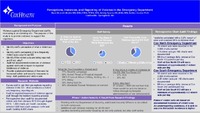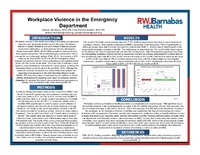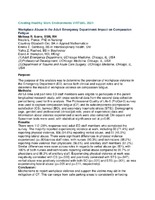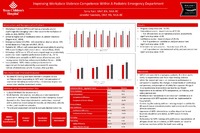| dc.contributor.author | Everett-Hinkle, Dusti | en |
| dc.contributor.author | Sparks, Ashley | en |
| dc.contributor.author | Coates, Keith | en |
| dc.date.accessioned | 2017-12-04T21:28:01Z | |
| dc.date.available | 2017-12-04T21:28:01Z | |
| dc.date.issued | 2017-12-04 | |
| dc.identifier.uri | http://hdl.handle.net/10755/623670 | |
| dc.description | <p>ENA 2017: Education, Networking, Advocacy. Held at America's Center Convention Center, St. Louis, Missouri, USA</p> | en |
| dc.description.abstract | <p>Session I presented Saturday, September 16, 2017</p>
<p><strong>Purpose:</strong> Violence against staff in the Emergency Department is seen as part of the role assumed when someone begins a career in emergency medicine. This research project set out to determine what staff in the emergency department percieved as a violent act, and how often violent acts are reported by staff compared to the actual incidence of violent acts against staff.</p>
<p><strong>Design:</strong> Emergency department staff were surveyed anonymously to discover their perception of what is a violent act, frequency of violence, and circumstances of reporting; A retrospective, randomized sampling of patient records, recording documentation of violent acts against staff; A quantitative data collection, in place for four months, that eleminated the reported percieved barriers to reporting violent acts to evaluate if an increase in reoprting would be seen; A qualitative literature review to investigate what interventions implemented in similar emergency departments had shown to improve the safety of the emergency department staff and increase the reporting of the violent acts.</p>
<p><strong>Setting:</strong> The setting of the real-time and retrospective data collection is an urban emergency department that is unique in that it has two locations in the same city. One of the locations is a Level 1 trauma center, seeing more than 75,000 patients per year. The other is located in a building that houses the inpatient psychiatric services for the organization, and that emergency department that has approximately 40,000 patient visits per year.</p>
<p><strong>Participants/Subjects:</strong> Emergency department staff were surveyed. The patient records reviewed were randomly selected, and no patient identifying information was recorded in the data collection.</p>
<p><strong>Methods:</strong> The initial survey sent to staff provided the team an opportunity to discover the staff's perception of violence and reporting of violent acts. The retrospective chart audits were performed on five hundred patient records, per campus, per month, for eight months. No patient identifying information was recorded, only the incidence of violent acts, and each incidence was recorded into pre-determined categories of violent acts varying in severity and type of violence.</p>
<p><strong>Results/Outcomes:</strong> The randomized retrospective sampling of patient records provided raw data, that we then were able to evaluate with statistical ananysis. While this analysis is still in process, thus far we have been able to discover that at one campus patients are responsible for 4.5 volent acts per day, and at the other campus, patients are responsible for 2 violent acts per day. In comparing the raw data collected during the chart audits, to the reports of violent acts recorded by the security department, we were able to prove that these acts of violence are not being reported consistently.</p>
<p><strong>Implications:</strong> The research team was able to prove our theory that violent acts are under-reported, and that the violence occurs much more frequently than the leadership and administration of the organization are aware of. The team is still working through a literature review to find the most promising interventions found to improve staff safety in other emergency departments, that would be appropriate for consideration in this organization, and will be making a proposal after the literature review is concluded.</p> | en |
| dc.format | Text-based Document | en |
| dc.language.iso | en | en |
| dc.subject | Workplace Violence | en |
| dc.subject | Prevalence | en |
| dc.subject | Emergency Department | en |
| dc.title | Perceptions, instances, and reporting of violence in the emergency department | en_US |
| dc.type | Poster | en |
| dc.rights.holder | <p>
All rights reserved by the author(s) and/or publisher(s) listed in this item record unless relinquished in whole or part by a rights notation or a Creative Commons License present in this item record.
</p><p>
All permission requests should be directed accordingly and not to the Sigma Repository.
</p><p>
All submitting authors or publishers have affirmed that when using material in their work where they do not own copyright, they have obtained permission of the copyright holder prior to submission and the rights holder has been acknowledged as necessary.
</p> | |
| dc.description.note | <p>Items submitted to a conference/event were evaluated/peer-reviewed at the time of abstract submission to the event. No other peer-review was provided prior to submission to the Henderson Repository, unless otherwise noted.</p> | |
| dc.type.category | Full-text | en |
| dc.evidence.level | N/A | en |
| dc.research.approach | N/A | en |
| dc.contributor.department | Non-member | en |
| dc.author.details | Dusti Everett-Hinkle, BSN, RN, CCRN, TCRN, CEN; Ashley Sparks, RN; Keith Coates, PhD | en |
| dc.conference.name | Emergency Nursing 2017 | en |
| dc.conference.host | Emergency Nurses Association | en |
| dc.conference.location | St. Louis, Missouri, USA | en |
| dc.date.conferenceyear | 2017 | |
| dc.description.reviewtype | Abstract Review Only: Reviewed by Event Host | en |
| dc.description.acquisition | Proxy-submission | en |





